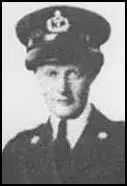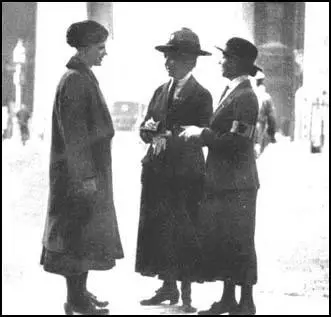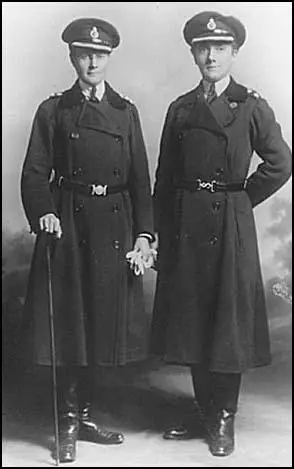Margaret Damar Dawson

Margaret Damer Dawson, the daughter of Richard Dawson, a surgeon, and his wife, Agnes Baird Hemming,was born at 1 York Road, Hove, Sussex, on 12 June 1873. She was educated at the London Academy of Music, where she studied music under Benno Schoenberger and Herbert Sharpe.
According to her biographer, David Doughan: "Her independent income enabled Margaret Dawson to move in well-to-do circles, and it supported her in her campaigns. In her adult years she became involved with various philanthropic activities. Although she later helped found a home for abandoned babies, her most notable activity at this period was campaigning for the humane treatment of animals, particularly but not exclusively on the continent." In 1906 she became organizing secretary of the International Animal Protection Societies in 1906. As a result of her work for animal welfare Dawson was awarded silver medals by Finland and Denmark. She was also active in the in the Animal Defence and Anti-Vivisection Society.
Dawson was not active in the women's suffrage movement, but she did take an interest in such feminist issues as the campaign against the traffic in women and children, and served on the Criminal Law Amendment Committee in 1914. It was during this campaign that she became friends with Nina Boyle of the Women's Freedom League.
On the outbreak of the First World War, Dawson was asked to help find British homes for Belgian refugees. Dawson was shocked to discover attempts by British men at railway stations attempting to recruit Belgian women as prostitutes.

After a meeting with Sir Edward Henry, the Chief Commissioner of Police, Dawson and Nina Boyle founded the Women Police Volunteers. The following year Dawson became Commandant and Mary Allen became Sub-Commandant. The government had always opposed the idea of policewomen but with a large numbers of policemen joining the British Army, it was considered a good idea to have women volunteers to help run the service. Another reason that Dawson's proposal was accepted was that her members were willing to work without pay.
According to Rebecca Jennings, the author of A Lesbian History of Britain (2007): "Mary Allen's enthusiasm was shared by Margaret Damer Dawson, and the two soon established a close professional and personal relationship, living together in London between 1914 and 1920."David Doughan argues that Margaret Damar Dawson was the right kind of leader for this new organisation: "Many of the first recruits, numbering approximately fifty, had experience of being imprisoned as militant suffragists, a point which was stressed by the rival Women's Police Patrols, set up by the National Union of Women Workers (later the National Council of Women). Margaret Damer Dawson's highly respectable non-suffragette background, together with the number of her aristocratic acquaintances, was thus an asset when dealing with figures of authority."
In 1915 Dawson renamed her organisation, the Women's Police Service (WPS). At first the WPS concentrated its work in the London area. Wearing a dark-blue uniform, the WPS were assigned responsibilities such as looking after the welfare of refugees.

In 1916 the Admiralty recruited a member of the WPS as an undercover worker in an attempt to expose spying and drug taking at the Scapa Flow Naval Base. The Ministry of Munitions also used the WPS to search women workers at its factories. At Gretna, near Carlisle, over 9,000 women were employed to produce munitions and 150 members of the WPS had the responsibility of searching them when they entered and left the factory.
By 1918 there were WPS women on duty in Edinburgh, Birmingham, Glasgow, Bristol, Belfast, Oxford, Cambridge, Portsmouth, Hull, Plymouth, Brighton, Nottingham, London, Southampton, Folkestone, Reading and Grantham. However, in many cases they were not sworn in as full members of the local police force and could not make arrests.
When the Armistice was signed, there were over 357 members of the Women's Police Service. Commandant Dawson and Subcommandant Mary Allen, asked the Chief Commissioner, Sir Nevil Macready, to make them a permanent part of his force. He refused, saying that the women were "too educated" and would "irritate" male members of the force. Macready instead decided to recruit and train his own women. However, Dawson was awarded the OBE for services to her country during wartime.
Ill-health forced Dawson to retire in 1919 and she was replaced as Commandant of the Women's Police Service by Mary Allen. Margaret Damer Dawson died died of a heart attack on 18th May 1920 at her home, Danehill Lodge, in Lympne, Kent.
Rebecca Jennings has argued that: "When Dawson died in 1920, Allen was a major beneficiary in her will, continuing to live in Dawson's house, Danehill, throughout the 1930s and beginning a relationship in the early 1920s with another former WPS officer Miss Helen Tagart."
Primary Sources
(1) Rebecca Jennings, A Lesbian History of Britain (2007)
A number of voluntary women police organisations were also established by middle and upper-class women, as an extension of the growing involvement of such women in social welfare and factory inspection work. At the outbreak of war, the feminist National Union of Working Women (NUWW) proposed a force of non-uniformed volunteer patrols, while a number of women from a more militant Suffragette background, including Margaret Damer Dawson and Nina Boyle, established the uniformed professional Women's Police Volunteers (WPV). When a disagreement over the role of the WPV occurred soon afterwards, Margaret Damer Dawson and Mary Allen broke with Nina Boyle and established a further group, the Women Police Service (WPS). The central role of women police during the war was the policing and protection of women, with a focus on moral welfare work, in the context of widespread anxieties about female promiscuity. Women police patrolled parks, the perimeters of garrisons and other public spaces, separating men and women who were thought to be engaging in immoral or inappropriate behaviour and following suspect couples to prevent illicit sexual encounters. Continuing a practice of the late-nineteenth- and early-twentieth-century moral purity groups, women police also entered public houses and other sites of "ill-repute". By 1916, the WPS were also heavily involved in patrolling and inspecting munitions factories where women were employed, to ensure the moral conduct of the women factory workers.
Many of the early women police recruits were from the educated middle class and were drawn into the work through their involvement in feminist politics before the war. Both Nina Boyle and Mary Allen had been members of the militant suffrage group the Women's Social and Political Union (WSPU) and the WPS maintained a strong feminist outlook, campaigning for an independent professional women's police force with equal powers to policemen....
Mary Allen's enthusiasm was shared by Margaret Damer Dawson, and the two soon established a close professional and personal relationship, living together in London between 1914 and 1920. When Dawson died in 1920, Allen was a major beneficiary in her will, continuing to live in Dawson's house, Danehill, throughout the 1930s and beginning a relationship in the early 1920s with another former WPS officer Miss Helen Tagart.
